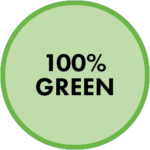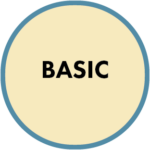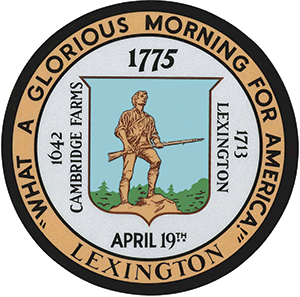Renewable Energy Content Detail
The Commonwealth of Massachusetts requires that all electricity supply products include a minimum of 59% from renewable energy resources in 2023, 62% in 2024, 63% in 2025, and 69% in 2026. Lexington’s Basic option meets this minimum requirement. Lexington’s 100% Green and New England Green options exceed this requirement by providing renewable electricity that is 100% from renewable sources.

100% renewable energy* (MA Class I RECs + National Wind RECs = 100%) |

100% renewable energy from the New England region* (100% MA Class I RECs) |

Minimum renewable energy required by law |
Eversource’s Basic Service |
|||||||||||||
| 2023 | 2024 | 2025 | 2026 | 2023 | 2024 | 2025 | 2026 | 2023 | 2024 | 2025 | 2026 | 2023 | 2024 | 2025 | 2026 | |
| Renewable energy added voluntarily by Lexington (Voluntary renewable energy amounts decrease as the amount of renewable energy required by the state increases.) | ||||||||||||||||
| From new regional resources (MA Class I RECs) | 20% | 20% | 20% | 20% | 78% | 76% | 73% | 70% | – | – | – | – | – | – | – | – |
| From wind projects outside of New England (National Wind RECs) | 58% | 56% | 53% | 50% | – | – | – | – | – | – | – | – | – | – | – | – |
| Renewable energy required by the State of Massachusetts | ||||||||||||||||
| From new resources in the New England region | 22% | 24% | 27% | 30% | 22% | 24% | 27% | 30% | 22% | 24% | 27% | 30% | 22% | 24% | 27% | 30% |
| From other clean or renewable sources | 37% | 38% | 36% | 39% | 37% | 38% | 36% | 39% | 37% | 38% | 36% | 39% | 37% | 38% | 36% | 39% |
| Total from renewable sources | 137% | 138% | 136% | 139% | 137% | 138% | 136% | 139% | 59% | 62% | 63% | 69% | 59% | 62% | 63% | 69% |
| Exit terms | Leave any time. No penalty or fee. |
Leave any time. No penalty or fee. |
Leave any time. No penalty or fee. | Leave any time. No penalty or fee. However, large C&I (rates G-3, T-2, and WR) and street lighting customers on the fixed-price Basic Service option may receive a billing adjustment, which may be either a credit or a charge. | ||||||||||||
* The 100% Green and New England Green options provide 100% renewable energy from emissions-free sources. To meet state requirements, Lexington’s electricity supplier must also purchase energy from other sources, some that are renewable but not clean and some that are clean but not renewable. As a result, the total of the renewable content for both 100% Green and New England Green exceeds 100%.
What are MA Class I RECs?
MA Class I RECs are renewable energy certificates (RECs) from renewable energy projects that began commercial operation after 1997, generate electricity using any of the following technologies, and meet all other program eligibility criteria:
- Solar photovoltaic
- Solar thermal electric
- Wind energy
- Small hydropower
- Landfill methane and anaerobic digester gas
- Marine or hydrokinetic energy
- Geothermal energy
- Eligible biomass fuel
Purchasing MA Class I RECs helps to create demand for more renewable energy on the New England grid. By purchasing more MA Class I RECs than is required by state law, you can help to drive the development of new renewable energy projects in our region.
What are National Wind RECs?
National Wind RECs are renewable energy certificates (RECs) that come from wind projects outside of New England.
Purchasing National Wind RECs does not help to build demand for renewable energy in New England because these projects are based outside of New England. And because National Wind REC prices are low, purchasing these RECs has a smaller impact on renewable energy development.
However, National Wind RECs are typically less expensive than MA Class I RECs and allow you to support renewable energy more affordably. Purchasing National Wind RECs enables you to direct your dollars to renewable sources and not to fossil-fuel-based electricity generators.
What is required by Massachusetts state law?
Massachusetts state law requires all electricity suppliers include a minimum amount of electricity from renewable and clean sources, and that minimum amount increases every year. The law includes a requirement to purchase electricity from both MA Class I-eligible sources and also additional renewable / clean sources.
What are the additional renewable / clean sources referred to in the table?
The phrase “additional renewable / clean sources” refers to the renewable energy required by state law other than MA Class I RECs. Some of these sources are renewable, but not emission free, such as waste-to-energy, which is electricity generated from burning solid waste, and some of those sources are clean but not classed as renewable, such as nuclear.
How can the total renewable content exceed 100%?
Lexington is committed to providing 100% clean, renewable energy through the 100% Green and New England Green options in the program.
Massachusetts state law requires the inclusion of a minimum amount of electricity from renewable or clean sources in all electricity that is sold, and it comes from a combination of MA Class I sources and other sources. However, while the MA Class I sources are both clean and renewable, some of the other required sources are clean but not renewable, and some are renewable but not clean.
To ensure participants in the 100% Green and New England Green options are receiving 100% of their electricity from sources that are both renewable and clean, Lexington counts only the MA Class I component of the state law requirement when deciding how much additional renewable energy to buy. To state it another way, Lexington buys additional renewable energy to make up the difference between the required MA Class I amount and 100%.
Because Lexington’s electricity supplier is also required to buy electricity from non-MA Class I sources, the total amount of renewable / clean energy purchased is more than 100% of the amount used by participants in the 100% Green and New England Green options. By participating in the 100% Green and New England Green options, you are therefore purchasing more renewable electricity than you use, but you are taking a big step toward supporting renewable energy and toward building demand for more renewable energy on our local grid.

